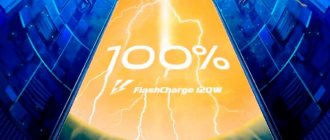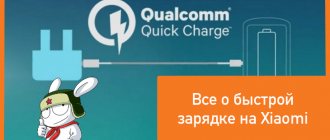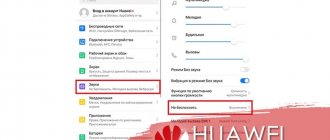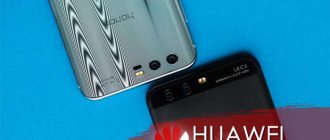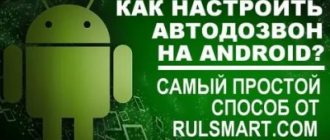What is fast charging
Huawei fast charging may be called "Super Charge" or "Quick Charge". The principle of operation is almost the same as that of conventional charging, only the battery energy is replenished many times faster due to high power.
Fast charging (QC) works as follows:
- A powerful charger supplies current to the battery many times faster.
- The battery charges up to 50 percent quickly. But having passed this mark, current begins to flow into the battery more slowly. After 80 percent of the charge, current flows as usual without using Quick Charge. This measured supply of energy to the battery is possible thanks to special built-in sensors.
The principle of accelerated charging on Huawei is simple. You connect the device to a power outlet, and the battery charge begins to actively replenish.
How does Quick Charge work?
Fast charging is a development from Qualcomm, which is known for its processors for mobile devices. The technology is based on increasing the current that flows into the phone's battery through the power supply - due to this, the total time it takes to fill the battery is significantly reduced.
There are also technologies from other manufacturers, for example, Huawei offered its own - Super Charge. Today it is named one of the fastest ways to charge a mobile device. For example, a 3400 mAh battery was charged to 100% in 73 minutes using Supercharge.
The question arises: “Is fast charging harmful to the battery?” Answer: no. Current and voltage indicators do not affect the battery in any way. The only thing that can be dangerous is high temperature. Sometimes devices overheat from Supercharge, and if the processor doesn't keep up with these changes, it can negatively impact battery performance.
Today, such charging is available in three versions:
- Quick Charge 2.0 – in about half an hour the phone is charged to 50%, after which it takes the same amount of time to reach 100%;
- Quick Charge 3.0 – it takes about 35-40 minutes for the device’s battery to charge to 80%;
- Quick Charge 4.0 is an optimized version of the previous version; the body of the gadget practically does not heat up.
The general feature is that at first the battery is quickly charged by half or a third, and further filling of the battery is a little slower. Due to this, the phone does not overheat.
Since 2015, the manufacturer has been introducing the Quick Charge 3.0 standard into smartphones. If the phone was released earlier than 2013, then it will definitely not use fast charging technology. Also, not all models of the brand support it. We list below exactly which devices can charge quickly.
Is fast charging harmful for phones?
This technology practically does not harm the battery of a mobile phone. Such chargers can cause serious damage to the battery only if increased current is supplied throughout the entire charge cycle.
The technology for restoring battery capacity at an accelerated pace is programmed in such a way that when the battery reaches 70% charge, charging is transferred to normal operation.
The negative impact on the battery is not the use of this type of technology, but the frequent and incomplete restoration of the battery capacity. The battery is designed for a limited number of charge/discharge cycles, so if the gadget is connected to the adapter several times a day, then, naturally, the entire battery life will be used up within 1 year.
To prevent the battery from wearing out very quickly when using fast charging, it is recommended that after connecting the adapter, charge the battery to 100% or, better yet, 90-95%. In addition, it is not advisable to completely discharge the battery.
The charger should be connected when the charge level drops to 15 - 20%. Daily application of these simple rules will significantly increase the effective life of the battery when using wireless charging or in the fast capacity recovery mode.
Do you have any questions or something to add to the article? Then write to us about it in the comments. This will help make the material more complete and useful!
Huawei's flagships, presented in the spring of 2020, are impressive. Thus, the youngest in the series is the Huawei P20 Lite smartphone - according to the name, a slightly “stripped-down” version of the older flagship. The price for the “light” version of an advanced smartphone is two times lower than for a phone with the “Pro” prefix.
How does Quick Charge work?
Fast charging is a development from Qualcomm, which is known for its processors for mobile devices. The technology is based on increasing the current that flows into the phone's battery through the power supply - due to this, the total time it takes to fill the battery is significantly reduced.
There are also technologies from other manufacturers, for example, Huawei offered its own - Super Charge. Today it is named one of the fastest ways to charge a mobile device. For example, a 3400 mAh battery was charged to 100% in 73 minutes using Supercharge.
The question arises: “Is fast charging harmful to the battery?” Answer: no. Current and voltage indicators do not affect the battery in any way. The only thing that can be dangerous is high temperature. Sometimes devices overheat from Supercharge, and if the processor doesn't keep up with these changes, it can negatively impact battery performance.
Today, such charging is available in three versions:
- Quick Charge 2.0 – in about half an hour the phone is charged to 50%, after which it takes the same amount of time to reach 100%;
- Quick Charge 3.0 – it takes about 35-40 minutes for the device’s battery to charge to 80%;
- Quick Charge 4.0 is an optimized version of the previous version; the body of the gadget practically does not heat up.
The general feature is that at first the battery is quickly charged by half or a third, and further filling of the battery is a little slower. Due to this, the phone does not overheat.
Since 2015, the manufacturer has been introducing the Quick Charge 3.0 standard into smartphones. If the phone was released earlier than 2013, then it will definitely not use fast charging technology. Also, not all models of the brand support it. We list below exactly which devices can charge quickly.
Time is money: we continue to understand fast charging standards
In the first part of the article, we talked about the most common fast charging standards - Quick Charge and USB Power Delivery. In this part we will look at all other standards that can be considered fast charging. Apple Traditionally, all iPhones have been equipped with 1 A and 5 V chargers for the past 10 years - but, of course, this does not mean that they cannot be charged faster. Starting with the iPhone 6, users began to notice that if they use a 12 W iPad charger, the smartphone begins to charge faster: yes, it does not take a maximum current of 2.4 A, but 1.5-2 A is also not bad, which allows you to charge the iPhone much faster . Moreover, it turned out that Plus versions are charged with higher currents than regular ones.
More about Huawei: Forgot your Huawei (Honor) password - how to unlock your smartphone?
But it was still quite slow - if competitors offered to charge the battery by 50-60% in half an hour, then it was hardly possible to charge 20-30%. And only last year Apple finally decided to use fast charging using the Power Delivery (PD) standard.
To do this, you will need an original Lightning to USB-C cable, a power adapter with PD support (Apple recommends its own, 29-87 W, but does not prohibit the use of third-party ones) and an iPhone 8 or later. Having fulfilled all the requirements, you will receive a 50% charge in half an hour: yes, this is somewhat less than that of competitors, but still seriously faster than charging through the power adapter from the iPad, and many times faster than charging from the included 5-watt charger.
Of course, the question arises - what third-party adapters can be used? The answer is simple - those that are PD compatible. If you use adapters without its support - for example, with Quick Charge 3 - options are possible: in the worst case, you will get “standard” 1 A and 5 V, in the best case, there will be something similar to charging through an iPad adapter: the current will fluctuate from 1 to 2 A.
Huawei Fast Charge Protocol (FCP), Samsung Advanced Fast Charging and Motorola Turbo Power
I combined these technologies together for a reason, because in essence they are clones of QC 2.0. And if the creation of FCP can still be understood - after all, Huawei has its own Kirin processors, so the technology had to be changed, but Samsung and Motorola mainly use Qualcomm processors, so in essence their fast charging technologies are a simple rebranding.
These standards are compatible with QC 2.0 (except for FCP - but even there the adapters could often have protocol support from Qualcomm), that is, they are also compatible with each other. The maximum charging capacity from Motorola is up to 25 W, and as for the capacity gained, each manufacturer had their own say: for example, the Moto X Force (3760 mAh) should be charged to 80% in 45 minutes.
Mediatek Pump Express
At first I wanted to add this technology to the previous paragraph, because in essence it is also a QC clone. But unlike technologies like Samsung Advanced Fast Charging, which did not have a continuation, PE has three versions:
As you can see, the first two are a complete repetition of QC standards. Moreover, the same LeEco produced chargers that were compatible with both QC and PE.
The differences begin with PE 3.0 - if Qualcomm in QC 4.0 continues to use small currents (1-2 A) with high voltages (up to 20 V), then Mediatek decides to go the other way: the voltage ranges from 3 to 6 V, but the current can be greater than 5 A. Considering that most cables are rated at 3 A, PE 3.0 requires a special cable.
As for the supported chipsets, this is most of Mediatek Helio (funny, but the company does not disclose the full list) - for example, Meizu Pro 6 on Helio X25 with a 2560 mAh battery is fully charged using PE in just an hour.
As for backward compatibility, it’s officially... not there. True, Mediatek says that the PE 2.0 and 3.0 standards can work in parallel and be installed in devices together according to the manufacturer’s requirements. OPPO VOOC and OnePlus DASH Charge Essentially, OPPO and Vivo belong to the same concern BBK Electronics, so the difference between these technologies is only name.
VOOC first appeared in the Oppo Find 7 smartphone in 2021, and subsequently began to be used in various devices of the F, R and N series. As for OnePlus, the first smartphone to support DASH-VOOC is 1 3, and later this technology was used in every new OnePlus smartphone.
What makes it special? Like Mediatek, OnePlus decided to go the route of increasing current rather than voltage, ending up with the same 20W output as QC 3.0 in a different way - using 4A and 5V. Overheating, you say? Everything is taken into account, says 1: two cans are simultaneously charged with lower currents to reduce overheating. Moreover, part of the charging circuit is located in the power adapter to further reduce heating.
What did this lead to? That's right, if you want to use DASH, use only the included charger with the included wire. Are you saying Snapdragon supports QC? But not in the case of 1: using third-party adapters you will get no more than 1.5 A and 5 V. That is, instead of going towards standardization, it invents its own standard, incompatible with anything else.
More about Huawei: Firmware and unlocking of 3GG modem M-150-2, 827F9F, E3372E3370, E3372H-153 for all operators | Portal about video surveillance and security systems
What about charge speed? It is at the level of new QC, about 60% in 35 minutes. But at the same time, as I wrote above, you are “tied” to DASH, so whether it’s worth it is up to you to decide.
Huawei SuperCharge
If adapters with Huawei FCP were often compatible with QC 2.0, now the company has created a completely new fast charging format that is no longer compatible with any other. As for the characteristics, the standard is quite similar to DASH, here it is 5 A at 4.
But still, as much as 22.5 W makes this charging the leader in speed, which somewhat smooths out the disadvantages: for example, with its help, the battery of the Huawei Honor 10 smartphone with a capacity of 3400 mAh was fully charged in 73 minutes - an impressive result.
Meizu Super mCharge
At MWC 2021, Meizu managed to surprise by introducing really fast charging: with its help you can charge a 3000 mAh battery by 60% in 10 minutes, and fully in just 20!
All this is achieved thanks to a simply unprecedented power of 55 W - 2.5 times more than DASH and SuperCharge. It turns out thanks to a current of 5 A and a voltage of 11 V - yes, I think there is no need to say that a special cable and charging are required.
Alas, although the technology is extremely interesting, it has not yet entered the market, although more than a year has passed since the announcement.
Conclusion
As a result, as you can see, almost every more or less large smartphone manufacturer decided to release their own fast charging, often incompatible with competitors’ solutions. Of course, I can’t call this a good solution - the good news is that more and more large manufacturers, such as Apple and Qualcomm, are moving to one common Power Delivery standard, so let’s hope that others will follow suit.
Design and ergonomics of Honor 9 Lite
The most subjective part of the review is, as always, the design. It is very difficult to balance between different tastes. Therefore, I will try to be objective. I can’t say that I’m a fan of metal or glass cases, both materials have their pros and cons. Therefore, we must proceed from the general. If it looks nice and is practical for everyday use, both options have a right to exist.
And when there is a choice, you and I only benefit from this. Agree, Honor already has a solid metal 7X, it’s not worth repeating. Moreover, you need to maintain the ideology of the line. Despite the Lite prefix, Honor 9 inherited the general features of the body from Honor 8, and not from 9. Since the latter is more similar to Xiaomi M6 or vice versa, rather than a successor of the eighth model.
Rectangular body with rounded oval corners, tempered glass panels on both front and back with a slight convex effect to add elegance to the design. After a little over a week of use, no scratches were found. Both panels received a good olephobic coating; there will be no problems with grease marks. It's a pity that the company decided to completely abandon metal; the frame is made of plastic. Yes, this option feels cheap, especially when you hold it in your hand.
And Honor deserves our reproach. After all, metal alloys are not very expensive these days. But honestly, with daily contact you forget about this plastic part, especially if you use a case.
There is a dual camera on the back, and this is an important clarification, since there are four of them, and it hardly protrudes above the body, and does not look as ridiculous as it is done in the 7X. And the last most important part of the design element is on the front panel, I’m now talking about both the display and the frames around it. Pay attention to the neat, identical indents both above and below, and on the left and right. They are not super small, they are not frameless, but they look, to me, very aesthetically pleasing.
How good is the display?
You don't need more from a budget smartphone. The display itself received an IPS matrix with a non-standard diagonal of 5.65 inches. Full HD - resolution 2160 by 1080 pixels and with a variable aspect ratio standard of 18 by 9. This is a good quality screen, but not the best for this segment. The picture is smooth, the colors are saturated, although dull and white-dirty. And if you compare head-to-head with the same Redmi5+, then 9 Lite is noticeably inferior in all respects. Both in color rendition and brightness range. In Honor it is not very wide and you especially notice it at night.
However, the screen is still well calibrated and does not go into a warm or cool tone. And if suddenly you need to adjust the color temperature, the settings have both a standard preset and a very precise manual mode. The images are nice, the application either supports 2:1 aspect ratios, or the systems are adjusted automatically, or, if we are talking about video, it is scaled and cropped. It's good? Obviously not, but there are no other options.
The display supports multi-touch for 10 touches, double tap unlocking, and also has a night mode function for your eyes, it is large and this option usually has both advantages, more information can be placed, and disadvantages: increased dimensions and all that. Honor 9L can argue with this disadvantage, because it fits perfectly in your hand, does not slip or dig into your palm, its width allows you to use the smartphone in some situations with one hand and does not even cause any particular discomfort.
In addition, the system provides a mini window function, that is, a software reduction of the display diagonal, which helps to operate with one hand. Above the screen you can see two eyes for the front cameras, a multi-colored notification indicator and a metal grille on the earpiece. Even for $200, the user did not deserve USB; the body has our old friend micro USB, but it is worth paying tribute to the thoughtful ergonomics; the headphone jack is located on the bottom edge.
Thus, all the necessary entrances and exits are located here. There is also a second microphone on the rear panel for noise reduction. If we talk about the design, I personally liked it - a strict, symmetrical rectangular block. At the same time, glass panels and multi-colored body options, gray, black, blue, white, gave it the youthful effect that the brand strives for. In general, I think they hit the target audience. Great, having sorted out the clothes, I’ll move on to the head part.
The brains have migrated straight from the 7X and from a performance point of view, obviously, there are no changes in the 9. The computing part is performed by the not too old, but not the latest Kirin 659 processor, consisting of two blocks of 4 Cortex A53 cores. One unit operates at a frequency of 1.7 Hz, and the second produces a maximum value of 2.36 Hz. Depending on the task being performed, they complement each other. There are two versions with three or four gigabytes of RAM and thirty-two or 64 GB, respectively, of built-in storage.
Huawei processors are always equipped with high-speed modems. The main thing to remember is that there is a version for Asia and for Europe; if you buy on AliExpress now, in January 2021, you doom yourself to the fact that you will not be able to support the main 4G frequencies. Since the Chinese Honor 9 Lite does not have the B7 and B20 bands, only the European model can boast of them, be careful.
The hybrid tray supports either two nano-SIM or SIM and a flash drive up to 256 GB. The quality of communication, audibility, and speech transmission are excellent. The same can be said about the operation of the GPS; it is accurate and fast; there were no failures during the week of operation. As a separate bonus for themselves, everyone will be able to find an FM radio that works without the Internet with connected headphones.
By the way, the sound of the 9 Lite is quite average, even among similar devices. The external speaker is loud and this parameter is enough not to miss notifications in any situation. Wired sound quality also does not shine, as well as volume, despite the presence of built-in sound presets for different types of headphones, as well as an equalizer. Listening does not leave any emotions, either positive or negative.
How to enable fast charging on your phone
To enable or disable knowledge on a device, you do not need to perform any specific actions. But the default functionality does not work on all phones. If you find yourself in this situation, follow these steps:
- Open settings on your Huawei smartphone.
- Find the “Battery” section (in some devices it may be called differently).
- In the menu, select the item called “Fast charging”, and move the slider, on the contrary, to the active position.
To make sure that supercharge is activated and working, simply put your smartphone on charge and note the time. It should be significantly reduced.
What to do if your Huawei or Honor phone is not charging
The problem with charging a Huawei or Honor smartphone can be caused by the following main reasons :
- the electricity in the network is turned off;
- faulty socket;
- the charger or cable is damaged;
- damage to the micro USB or USB-C socket on the device itself;
- the current-carrying cable or contacts have failed;
- malfunction of the device;
- presence of viruses;
- The battery has failed.
If you are faced with such a problem and do not know what to do if your smartphone does not charge, then it is recommended to take the faulty device to a service center. But before that, check if the charge is coming from another charger.
We recommend that you familiarize yourself with the proprietary Huawei HiCare application, with which you can contact the official support service.
How to disable fast charging
If for some reason you need to disable quickcharge on your smartphone, you can do this as follows:
- Open the Settings section on your phone.
- In the “Maintenance” item, select the battery icon.
- Select the item where settings for the battery are made.
- In this menu we find the “Fast charging” item, drag the slider to the inactive state.
After these steps, the battery will charge as usual. You can activate the BZ at any time.
Install cell idle mode error fix.
Honor 7 sometimes falls victim to this cellular waiting bug that affects a number of devices running Android Lollipop and affects battery life. Unfortunately, this appears to attack devices even when Airplane mode is enabled.
The good news is that one of the Senior XDA forum members, Bazoocaze, has developed a fix for this problem. You can read the full explanation and download the patch at this link.
Let us know your favorite Honor 7 battery tips below.
Views: 53
How to properly charge your smartphone
However, Huawei's smart charging mode will have another function besides slowing down. Judging by the description, it will allow, in principle, to block the energy supply when the battery reaches 80%. This is a cool idea that the Chinese probably picked up from Tesla.
Elon Musk has repeatedly said that charging any battery to 80% on a regular basis has less negative impact on it than if it were charged to 100%. That is why the Tesla app has a special function that allows you to set a limit after which charging will automatically stop.
Everything you need to know about Huawei Pay in Russia
Review your energy saving settings.
Your first stop in the quest to improve your Honor 7's battery life is the power saving settings. Honor 7 has three of them: Performance, Smart and Ultra. It's worth turning on the smart setting for everyday use because it keeps your battery charged with virtually no impact on performance.
On the other hand, Ultra mode should only be used as a last resort, as it severely limits the functionality of your device. It only allows calls and SMS messages and closes all other apps so they don't work or receive data. However, it is very effective as a means of increasing waiting time.
The improvements each battery saving setting provides can be seen on the right. / © ANDROIDPIT
What phones support bz
Huawei is constantly updating its line of smartphones. There is no point in listing all the models that have the Super Charge function, since there are many of them.
But if you decide to buy an outdated Huawei model or buy a device second-hand, then most likely there will be no knowledge base support.
The technology appeared relatively recently. But almost any new smartphone priced above the average price category will have this nice option. Before buying a smartphone, make sure that it has the necessary functionality. If you have already bought a phone and want to make sure whether this technology is present in it, you can find information about this on the box or in the model description on the Internet.
Answers to popular questions
Is wireless charging harmful?
According to recent studies, wireless charging does not have any harmful effects on either the person or the device being charged. In addition, this technology is becoming more popular and improving. Therefore, every year there are more and more smartphone models that can be charged without standard charging.
How often can a phone be charged using an external battery?
PowerBank does not cause any harm to the battery. You can charge a Huawei or Honor smartphone from it an unlimited number of times.
Should I charge the battery overnight?
Many users leave their phone on charge overnight. It is worth noting that the Honor 10 smartphone stops charging the battery on its own after the capacity is maximally filled. In this regard, the smartphone owner will not take much risk and deteriorate the battery performance if he leaves the device on charge overnight.
It is worth noting that some experts believe that when charging for a long time, it is preferable to remove the smartphone from the case to avoid possible overheating.
